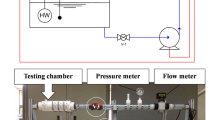Abstract
Heat power engineering (HPE) consumes significant volumes of water. There are, therefore, problems associated with corrosion, biological fouling, salt deposits, and sludge formation on functional surfaces of heat power equipment. One of the effective ways to solve these problems is the use of inhibitory protection. The development of new Russian import-substituting environmentally friendly inhibitors is very relevant. This work describes experimental results on the OPC-800 inhibitor (TU 2415-092-00206 457-2013), which was produced at Karpov Chemical Plant and designed to remove mineral deposits, scale, and biological fouling from the surfaces of water-rotation node systems on HPE objects. This reagent is successfully used as an effective corrosion inhibitor in the water recycling systems of Tatarstan petrochemical enterprises. To save fresh make-up water, the circulating system is operated in a no-blow mode, which is characterized by high evaporation and salt content coefficients. It was experimentally found that corrosion rate upon treatment of recycled water with the OPC-800 inhibitor is 0.08–0.10 mm/year. HPE mainly uses inhibitors based on oxyethylidene diphosphonic (OEDPA) and nitrilotrimethylphosphonic (NTMPA) acids. The comparative characteristic of inhibition efficiency for OPC-800 and OEDF-Zn-U2 is given. The results obtained indicate that OPC-800 can be used as an inhibitor for treatment of cooling water in HPE plants. In this case, it is necessary to take into account the features of water rotation of a thermal power plant.
Similar content being viewed by others
References
D. I. Khasanova, E. A. Kovrizhnykh, and D. Kh. Safin, “Environmentally friendly inhibitors for petrochemical production water recycling systems,” Khim. Prom-st. Segodnya, No. 8, 31–38 (2015).
Yu. V. Balaban-Irmenin, V. Kh. Lipovskikh, and A.M. Rubashov, Internal Corrosion Protection for Pipelines of Water Heating Networks (Energoatomizdat, Moscow, 1999).
RD 153-34.1-17.465-00. Normative Document for Thermal Power Stations, Boiler and Heating Networks. Methodological Guidelines for the Assessment of Internal Corrosion Processes Intensity in Heating Networks (Vseross. Teplotekh. Inst., Moscow, 2001).
F. F. Chausov, “Effectiveness of phosphonate-zincate inhibitors of scale and corrosion: Comparative laboratory studies,” Ekol. Prom-st. Rossii, No. 9, 28–33 (2008).
Author information
Authors and Affiliations
Corresponding author
Additional information
Original Russian Text © L.A. Nikolaeva, D.I. Khasanova, E.R. Mukhutdinova, D.Kh. Safin, I.G. Sharifullin, 2017, published in Teploenergetika.
Rights and permissions
About this article
Cite this article
Nikolaeva, L.A., Khasanova, D.I., Mukhutdinova, E.R. et al. Safe corrosion inhibitor for treating cooling water on heat power engineering plants. Therm. Eng. 64, 623–625 (2017). https://doi.org/10.1134/S0040601517080080
Received:
Accepted:
Published:
Issue Date:
DOI: https://doi.org/10.1134/S0040601517080080




